Makita AN453 User Manual

INSTRUCTION MANUAL MANUEL D'INSTRUCTION
MANUAL DE INSTRUCCIONES
Pneumatic Roofing Coil Nailer Cloueuse pneumatique pour toiture Clavadora neumática
(para clavos de techados)
AN453
008388
 WARNING:
WARNING:
For your personal safety, READ and UNDERSTAND before using. SAVE THESE INSTRUCTIONS FOR FUTURE REFERENCE.
 AVERTISSEMENT:
AVERTISSEMENT:
Pour votre propre sécurité, prière de lire attentivement avant l'utilisation. GARDER CES INSTRUCTIONS POUR RÉFÉRENCE ULTÉRIEURE.
 ADVERTENCIA:
ADVERTENCIA:
Para su seguridad personal, LEA DETENIDAMENTE este manual antes de usar la herramienta.
GUARDE ESTAS INSTRUCCIONES PARA FUTURA REFERENCIA.

ENGLISH
SPECIFICATIONS
Model |
AN453 |
Air pressure |
4.5 - 8.5 kgf/cm2G (65 - 120 PSIG) |
Nail length |
19 mm (3/4") - 45 mm (1-3/4") |
Nail capacity |
120 pcs. |
Min. hose diameter |
6.5 mm (1/4") |
Dimensions (L X H X W) |
265 mm X 269 mm X 117 mm (10-3/8" X 10-5/8" X 4-5/8") |
Net weight |
2.4 kg (5.2 lbs) |
•Due to our continuing programme of research and development, the specifications herein are subject to change without notice.
•Note: Specifications may differ from country to country.
USB087-1
IMPORTANT SAFETY INSTRUCTIONS
WARNING: WHEN USING THIS TOOL, BASIC SAFETY PRECAUTIONS SHOULD ALWAYS BE FOLLOWED TO REDUCE THE RISK OF PERSONAL INJURY, INCLUDING THE FOLLOWING:
READ ALL INSTRUCTIONS.
1.For personal safety and proper operation and maintenance of the tool, read this instruction manual carefully before using the tool.
2.Always wear safety glasses to protect your eyes from dust or nail injury. The safety glasses should conform with the requirements of ANSI Z87.1.
WARNING:
It is an employer's responsibility to enforce the use of safety eye protection equipment by the tool operators and by other persons in the immediate working area.
3.Wear hearing protection to protect your ears against exhaust noise and head protection. Also wear light but not loose clothing. Sleeves should be buttoned or rolled up. No necktie should be worn.
4.Rushing the job or forcing the tool is dangerous. Handle the tool carefully. Do not operate when under the influence of alcohol, drugs or the like.
5.General Tool Handling Guidelines:
(1)Always assume that the tool contains fasteners.
(2)Do not point the tool toward yourself or anyone whether it contains fasteners or not.
(3)Do not actuate the tool unless the tool is placed firmly against the workpiece.
(4)Respect the tool as a working implement.
(5)No horseplay.
(6)Do not hold or carry the tool with a finger on the trigger.
(7)Do not load the tool with fasteners when any one of the operating controls is activated.
(8)Do not operate the tool with any power source other than that specified in the tool operating/safety instructions.
6.An improperly functioning tool must not be used.
7.Sparks sometimes fly when the tool is used. Do not use the tool near volatile, flammable materials such as gasoline, thinner, paint, gas, adhesives, etc.; they will ignite and explode, causing serious injury.
8.The area should be sufficiently illuminated to assure safe operations. The area should be clear and litter-free. Be especially careful to maintain good footing and balance.
9.Only those involved in the work should be in the vicinity. Children especially must be kept away at all times.
10.There may be local regulations concerning noise which must be complied with by keeping noise levels within prescribed limits. In certain cases, shutters should be used to contain noise.
11.Do not play with the contact element: it prevents accidental discharge, so it must be kept on and not removed. Securing the trigger in the ON position is also very dangerous. Never attempt to fasten the trigger. Do not operate a tool if any portion of the tool operating controls is inoperable, disconnected, altered, or not working properly.
12.Operate the tool within the specified air pressure on the tool label for safety and longer tool life. Do not exceed the recommended max. operating pressure. The tool should not be
connected to a source whose pressure potentially exceeds 14.0 kgf/cm2G (200 PSIG).
2

13.Never use the tool with other than compressed air. If bottled gas (carbon dioxide, oxygen, nitrogen, hydrogen, air, etc.) or combustible gas (hydrogen, propane, acetylene, etc.) is used as a power source for this tool, the tool will explode and cause serious injury.
14.Always check the tool for its overall condition and loose screws before operation. Tighten as required.
15.Make sure all safety systems are in working order before operation. The tool must not operate if only the trigger is pulled or if only the contact element is pressed against the wood. It must work only when both actions are performed. Test for possible faulty operation with nails unloaded and the contact element in fully pulled position.
16.Check walls, ceilings, floors, roofing and the like carefully to avoid possible electrical shock, gas leakage, explosions, etc. caused by striking live wires, conduits or gas pipes.
vicinity. Keep hands and feet away from the ejection port area.
25.When the air hose is connected, do not carry the tool with your finger on the trigger or hand it to someone in this condition. Accidental firing can be extremely dangerous.
26.Handle the tool carefully, as there is high pressure inside the tool that can be dangerous if a crack is caused by rough handling (dropping or striking). Do not attempt to carve or engrave on the tool.
27.Stop nailing operations immediately if you notice something wrong or out of the ordinary with the tool.
28.Always disconnect the air hose and remove all of the nails:
(9)When unattended.
(10)Before performing any maintenance or repair.
(11)Before cleaning a jam.
(12)Before moving the tool to a new location.
17.Use only nails specified in this manual. The 29. Perform cleaning and maintenance right after
use of any other nails may cause malfunction of the tool.
18.Do not permit those uninstructed to use the tool.
19.Make sure no one is nearby before nailing. Never attempt to nail from both the inside and outside at the same time. Nails may rip through and/or fly off, presenting a grave danger.
finishing the job. Keep the tool in tip-top condition. Lubricate moving parts to prevent rusting and minimize friction-related wear. Wipe off all dust from the parts.
30.Do not modify tool without authorization from Makita.
31.Do not attempt to keep the trigger or contact element depressed with tape or wire. Death or serious injury may occur.
20.Watch your footing and maintain your balance 32. Always check contact element as instructed in
with the tool. Make sure there is no one below when working in high locations, and secure the air hose to prevent danger if there is sudden jerking or catching.
21.On rooftops and other high locations, nail as you move forward. It is easy to lose your footing if you nail while inching backward. When nailing against perpendicular surface, nail from the top to the bottom. You can perform nailing operations with less fatigue by doing so.
22.A nail will be bent or the tool can become jammed if you mistakenly nail on top of another nail or strike a knot in the wood. The nail may be thrown and hit someone, or the tool itself can react dangerously. Place the nails with care.
23.Do not leave the loaded tool or the air compressor under pressure for a long time out in the sun. Be sure that dust, sand, chips and foreign matter will not enter the tool in the place where you leave it setting.
24.Do not point the ejection port at anyone in the
this manual. Nails may be driven accidentally if the safety mechanism is not working correctly.
33.Ask Makita's Authorized service centers for periodical inspection of the tool.
34.To maintain product SAFETY and RELIABILITY, maintenance and repairs should be performed by Makita Authorized or Factory Service Centers, always using Makita replacement parts.
SAVE THESE INSTRUCTIONS.
 WARNING:
WARNING:
MISUSE or failure to follow the safety rules stated in this instruction manual may cause serious personal injury.
3
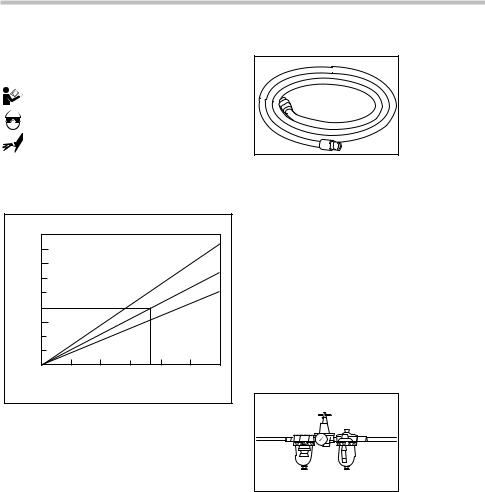
USD501-1
Symbols
The followings show the symbols used for tool.
Read and understand tool labels and manual.
Operators and others in work area must
wear safety glasses with side shields.Keep fingers away from trigger when
not driving fasteners to avoid accidental firing.
INSTALLATION
Selecting compressor
|
(cfm |
ft3/min) |
|
|
|
|
|
|
|
|
perminute |
4.5 |
|
|
|
|
|
|
|
|
|
4.0 |
|
|
|
|
|
G(115PSIG) |
|
|||
3.5 |
|
|
|
|
|
|
||||
|
|
|
|
|
2 |
|
||||
3.0 |
|
|
|
|
|
|
||||
|
|
|
|
|
2 |
|
||||
|
|
|
|
|
|
|
|
|||
|
2.5 |
|
|
. |
|
|
|
G(100PSIG) |
||
|
|
|
|
|
|
2 |
|
|||
output |
|
|
|
|
.0Kgf/cm |
G(85PSIG) |
||||
2.0 |
|
|
|
7 |
.0Kgf/cm |
|
||||
|
|
|
|
|
||||||
air |
|
|
|
|
6 |
|
|
|
||
1.5 |
|
|
|
|
|
|
|
|
||
Compressor |
|
|
|
|
|
|
|
|
||
1.0 |
|
|
|
|
|
|
|
|
||
0.5 |
|
|
|
|
|
|
|
|
||
0 |
|
|
|
37 |
|
|
|
|
||
0 |
10 |
20 |
30 |
40 |
50 |
60 |
||||
|
||||||||||
|
|
|||||||||
|
|
Nailing frequence (times/min) |
|
|||||||
008423 |
|
|
|
|
|
|
|
|
|
|
The air compressor must comply with the requirements of ANSI B19.3.
Select a compressor that has ample pressure and air output to assure cost-efficient operation. The graph shows the relation between nailing frequency, applicable pressure and compressor air output.
Thus, for example, if nailing takes place at a rate of approximately 37 times per minute at a compression of 7.0 kgf/cm2G (100 PSIG), a compressor with an air output over 2 ft3/minute is required.
Pressure regulators must be used to limit air pressure to the rated pressure of the tool where air supply pressure exceeds the tool's rated pressure. Failure to do so may result in serious injury to tool operator or persons in the vicinity.
Selecting air hose
004294
Use an air hose as large and as short as possible to assure continuous, efficient nailing operation. With an air pressure of 5.0 kgf/cm2G (70 PSIG), an air hose with an internal diameter of over 6.5 mm (1/4") and a length of less than 20 m (6.6 ft.) is recommended when the interval between each nailing is 0.5 seconds. Air supply hoses shall have a minimum working pressure rating of 10.7 kgf/cm2G (150 PSIG) or 150 percent of the maximum pressure produced in the system whichever is higher.
 CAUTION:
CAUTION:
•Low air output of the compressor, or a long or smaller diameter air hose in relation to the nailing frequency may cause a decrease in the driving capability of the tool.
Lubrication |
004295 |
To insure maximum performance, install an air set (oiler, regulator, air filter) as close as possible to the tool. Adjust the oiler so that one drop of oil will be provided for every 30 nails.
When an air set is not used, oil the tool with pneumatic tool oil by placing 2 (two) or 3 (three) drops into the air fitting. This should be done before and after use. For proper lubrication, the tool must be fired a couple of times after pneumatic tool oil is introduced.
4
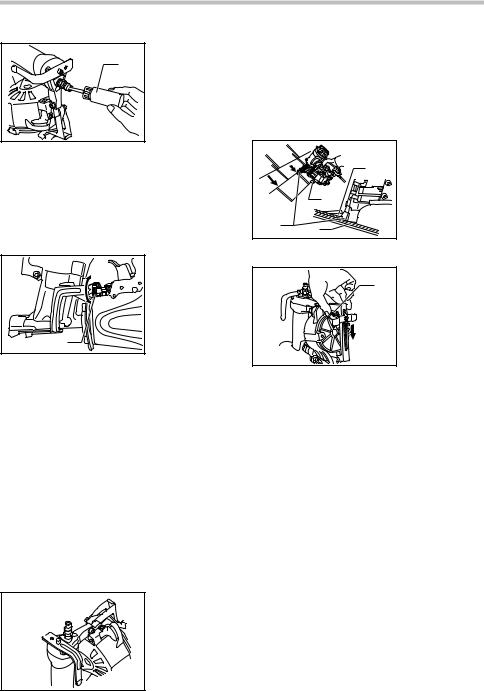
|
1. Pneumatic tool |
1 |
oil |
|
|
008389 |
|
FUNCTIONAL DESCRIPTION
 CAUTION:
CAUTION:
•Always disconnect the air hose before adjusting or checking function on the tool.
Adjusting depth of nailing
1. Adjuster
A
B
1
008390
To adjust the depth of nailing, turn the adjuster. The depth of nailing is the deepest when the adjuster is turned fully in the A direction shown in the figure. It will become shallower as the adjuster is turned in the B direction. If nails cannot be driven deep enough even when the adjuster is turned fully in the A direction, increase the air pressure. If nails are driven too deep even when the adjuster is turned fully in the B direction, decrease the air pressure. Generally speaking, the tool service life will be longer when the tool is used with lower air pressure and the adjuster set to a lower depth of nail driving.
 CAUTION:
CAUTION:
•Always disconnect the hose before adjusting the depth of nailing.
Hook
1. Hook
1
008405
 CAUTION:
CAUTION:
•Always disconnect the hose from the tool.
•Never hook the tool at high location or on potentially unstable surface.
The hook is convenient for hanging the tool temporarily.
Adjusting the shingle guide
|
4 |
|
2 |
1 |
3 |
|
|
008391 |
|
1.Contact element
2.Shingle guide
3.Shingle
4.Projection
1. Adjust plate
1 2. Lever

 2
2
008392
The shingle guide is designed for consistent shingle exposure. Place shingle in desired position.
Turn the lever clockwise to release the adjusting plate. Reset the tool on the exposed shingle with the projections of the contact element depressing the bottom of the previous row of the shingle. Slide the adjusting plate up against the bottom of the exposed shingle and turn the lever counterclockwise to lock the adjusting plate.
ASSEMBLY
 CAUTION:
CAUTION:
•Always disconnect the air hose before carrying out any work on the tool.
5
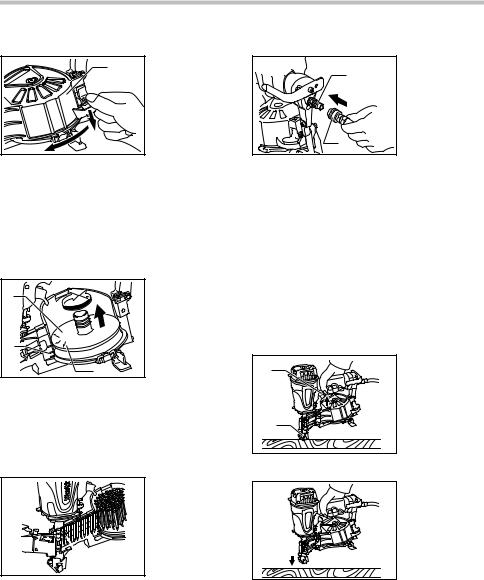
Loading nailer
1 |
1. |
Magazine cap |
|
2. |
Latch lever |
||
|
 2
2
008393
Select nails suitable for your work. Depress the latch lever and open the magazine cap.
Lift and turn the coil support plate so that the arrow with nail size indicated on the coil support plate will point to the corresponding graduation increment marked on the magazine. If the tool is operated with the coil support plate set to the wrong step, poor nail feed or malfunction of the tool may result.
|
1. Coil support |
1 |
plate |
|
2. Graduation |
|
3. Arrow |
2 |
|
|
3 |
008394 |
|
Place the nail coil over the coil support plate. Uncoil enough nails to reach the feed claw. Place the first nail in the driver channel and the second nail in the feed claw. Place other uncoiled nails on feeder body. Close the magazine cap after checking to see that the nail coil is set properly in the magazine.
1. Feed Claw
 1
1
008395
Connecting air hose
|
1. Air fitting |
1 |
2. Air socket |
2
008396
Slip the air socket of the air hose onto the air fitting on the nailer. Be sure that the air socket locks firmly into position when installed onto the air fitting. A hose coupling must be installed on or near the tool in such a way that the pressure reservoir will discharge at the time the air supply coupling is disconnected.
OPERATION
 CAUTION:
CAUTION:
•Make sure all safety systems are in working order before operation.
1.To drive a nail, you may place the contact element against the workpiece and pull the trigger, or
1 |
2 |
008397 |
008398 |
1.Trigger
2.Contact arm
2.Pull the trigger first and then place the contact
element against the workpiece.
•No. 1 method is for intermittent nailing, when you wish to drive a nail carefully and very accurately. No. 2 method is for continuous nailing.
6
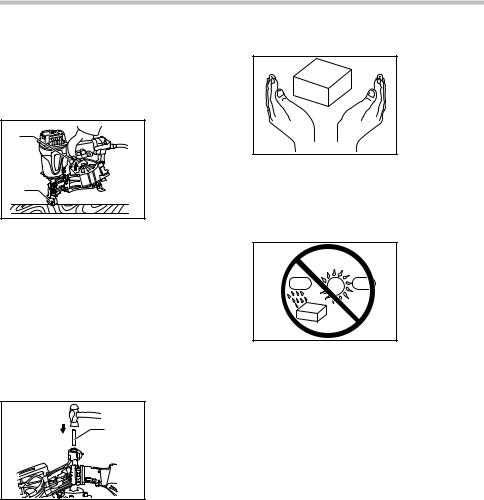
 CAUTION:
CAUTION:
•Operating the tool without nails shortens the life of the tool and should be avoided.
For squential trip trigger (accessory)
To drive a nail, you may place the contact element against the workpiece and pull the trigger.
1 |
1. Trigger |
2. Contact arm |
|
2 |
|
008397 |
|
 CAUTION:
CAUTION:
•WITH THE TRIGGER HELD IN A HALF-PULLED POSITION, an unexpected nailling could occur, if contact element is allowed to re-contacct against
the workpiece or the other sueface under the influence of recoil. In order to avoid this unexpected nailling, perform as follows;
A.Do not place the contact element against the workpiece with excessive force.
B.Pull the trigger fully and hold it on for 1-2 seconds after nailling.
Jammed nailer
1. Small rod
2. Ejection port
1
 2
2
008399
 CAUTION:
CAUTION:
•Always disconnect the air hose and remove the nails from the magazine before cleaning a jam.
When the nailer becomes jammed, do as follows:
Open the magazine cap and remove the nail coil. Insert a small rod or the like into the ejection port and tap it with a hammer to drive out the nail jamming from the ejection port. Reset the nail coil and close the magazine cap.
Nails
Nail
004310
Handle nail coils and their box carefully. If the nail coils have been handled roughly, they may be out of shape or their connector breaks, causing poor nail feed.
Avoid storing nails in a very humid or hot place or place exposed to direct sunlight.
Humid |
Hot |
Nail
004311
MAINTENANCE
 CAUTION:
CAUTION:
•Always disconnect the air hose from the tool before attempting to perform inspection or maintenance.
Cleaning and removal of tat and dirt
Adhesion of tar and dirt to areas around the contact element will prevent smooth movement of the contact element (safety mechanism), causing accidental discharge. Periodically clean the areas around the contact element.
Use a solvent such as kerosene, #2 fuel oil or diesel fuel. Immerse only the contact element and the areas around the ejection port in solvent and remove tar and dirt with brush. Always wear waterproof gloves to protect your hands. Never immerse the housing, magazine, etc. in solvent. Malfunction of the tool may result. Always dispose of the solvent used in a safe and prudent manner and in compliance with all local and national code requirement.
7
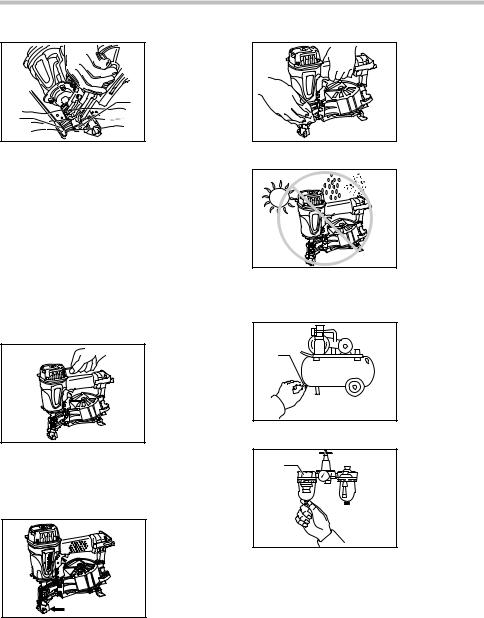
2 |
1 |
008401 |
1.Brush
2.Ejection port
008403
Dry off the tool before use. Any oil film left after cleanup will accelerate the tar buildup, and the tool will require more frequent recleaning. After drying off the tool, oil the moving parts to prevent rusting and to assure good lubrication and operation or moving parts.
 WARNING:
WARNING:
•Never use gasoline or other similar highly volatile liquids for cleaning. Vapors of such liquids may enter the tool and could be ignited by sparks produced during nailing and cause an explosion.
Maintenance of nailer
Always check the tool for its overall condition and loose screws before operation. Tighten as required.
008404
Maintenance of compressor, air set and air hose
1. Drain cock
1
004317
008402
1. Air filter
1
With tool disconnected, make daily inspection to assure free movement of the contact element and trigger. Do not use tool if the contact element or trigger sticks or binds.
008409
When the tool is not to be used for an extended period of time, lubricate the tool using pneumatic tool oil and store the tool in a safe place. Avoid exposure to direct sunlight and/or humid or hot environment.
8
004318
After operation, always drain the compressor tank and the air filter. If moisture is allowed to enter the tool, It may result in poor performance and possible tool failure. Check regularly to see if there is sufficient pneumatic oil in the oiler of the air set. Failure to maintain sufficient lubrication will cause O-rings to wear quickly.
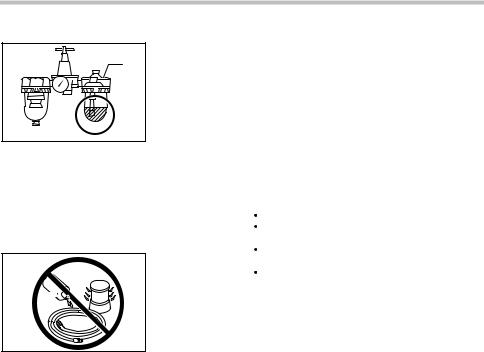
|
1. Oiler |
1 |
2. Pneumatic oil |

 2
2
004319
Keep the air hose away from heat (over 60°C, over 140°F), away from chemicals (thinner, strong acids or alkalis). Also, route the hose away from obstacles which it may become dangerously caught on during operation. Hoses must also be directed away from sharp edges and areas which may lead to damage or abrasion to the hose.
Stove
Thinner
004320
To maintain product SAFETY and RELIABILITY, repairs, any other maintenance or adjustment should be performed by Makita Authorized or Factory Service Centers, always using Makita replacement parts.
ACCESSORIES
 CAUTION:
CAUTION:
•These accessories or attachments are recommended for use with your Makita tool specified in this manual. The use of any other accessories or attachments might present a risk of injury to persons. Only use accessory or
attachment for its stated purpose.
If you need any assistance for more details regarding these accessories, ask your local Makita Service Center.
•Nails
•Air hoses
•Safety goggles
MAKITA LIMITED ONE YEAR WARRANTY
Warranty Policy
Every Makita tool is thoroughly inspected and tested before leaving the factory. It is warranted to be free of defects from workmanship and materials for the period of ONE YEAR from the date of original purchase. Should any trouble develop during this one year period, return the COMPLETE tool, freight prepaid, to one of Makita’s Factory or Authorized Service Centers. If inspection shows the trouble is caused by defective workmanship or material, Makita will repair (or at our option, replace) without charge.
This Warranty does not apply where:
repairs have been made or attempted by others:
repairs are required because of normal wear and tear:
the tool has been abused, misused or improperly maintained:
alterations have been made to the tool.
IN NO EVENT SHALL MAKITA BE LIABLE FOR ANY INDIRECT, INCIDENTAL OR CONSEQUENTIAL DAMAGES FROM THE SALE OR USE OF THE PRODUCT. THIS DISCLAIMER APPLIES BOTH DURING AND AFTER THE TERM OF THIS WARRANTY.
MAKITA DISCLAIMS LIABILITY FOR ANY IMPLIED WARRANTIES, INCLUDING IMPLIED WARRANTIES OF "MERCHANTABILITY" AND "FITNESS FOR A SPECIFIC PURPOSE," AFTER THE ONE YEAR TERM OF THIS WARRANTY.
This Warranty gives you specific legal rights, and you may also have other rights which vary from state to state. Some states do not allow the exclusion or limitation of incidental or consequential damages, so the above limitation or exclusion may not apply to you. Some states do not allow limitation on how long an implied warranty lasts, so the above limitation may not apply to you.
EN0006-1
9
